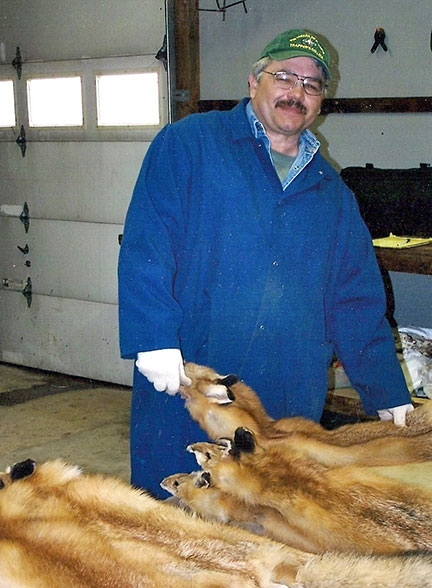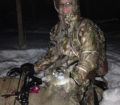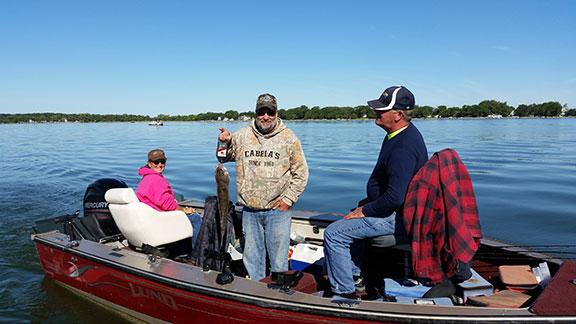By Steve Weisman
Outdoor Editor

(photo submitted) Mike Mazur checking pelts ready to go to Groenewold Fur & Wool Company.
There is little doubt that this year’s drought has had an effect on everything. Mike Mazur, owner of Northwest Iowa Fur Exchange located in the back of Kabele’s Trading Post notes that drought has definitely affected the fur business. “Obviously, with the lack of water, we are seeing very few muskrats. Everything seems to prey on them, so even when they attempt to migrate to areas of water, they pretty much get eaten. The fur business really revolves around the raccoon, but even they are having a hard time. With the lack of food and water, they have migrated closer to farmyards, where there are a lot of cats and feline distemper, which is very deadly to raccoons.”
All part the business
Still, it’s all part of the business says Mazur, who has been in the fur business for over 36 years. “I actually started in high school in Aurora, IA, and I have been a fur buyer for Groenewold Fur & Wool Company out of Forreston, IL since 1981. Groenewold is the largest fur buyer in the United States and has locations in Eastern Europe and Russia.” Over those 36 years, Mazur has been part of the up and down market and the changes that have occurred. For instance, Madur remembers as many as 323 fur buyers in Iowa in the 1980s with only 23 around now. Today, most of the furs harvested here in the United States end up overseas. China is the largest importer, followed by Russia. Other top importers include Korea, Turkey, Greece and Italy.
About his move to Spirit Lake, Mazur says, “I came to Spirit Lake a few years ago and became a partner with Ed Kabele. Then I bought the business when Ed retired a couple of years ago.”
Even though Mazur owns the Northwest Iowa Fur Exchange, he still remains a buyer and spends four days a week during the trapping season running routes across northwest Iowa and South Dakota. With route stops set up, fur harvesters know when and at what time Mazur will be in their vicinity. “I pull a big trailer to haul the furs that I buy. I will grade the fur right there and issue a check on the spot, but if they don’t like the price, they always have the choice not to sell.”
Take care of the fur
As Mazur says, “You can’t mishandle fur, because it is a perishable commodity. It must be taken care of right away. We will turn away fur. We simply won’t buy it if it is bad. To get the best prices, fur harvesters need to respect and have pride for both the animal and its pelt. Once the animal is harvested, it is important to take care of the pelt as soon as possible. The minute that animal is harvested, the pelt is as good as it will ever be.”
That holds true for both fur harvester and for fur buyers like Mazur. “It also holds true for us right here. When animals are brought in whole or furs brought in, and we purchase them, we need to take proper care of the pelt.” How does that work with Mazur on the road?
That’s where Thane Johnson, who with his wife Tanya own Kabele’s Trading Post, comes in. “When we bought Kabele’s, I got interested in what Mike and Ed were doing back in the fur area. Mike taught me how to trap and how to take care of the animals and the fur,” says Johnson.
Mazur says it has worked out well. “I know I can be on my routes, and Thane will take care of things back here. That’s the only way this would work.”
Fur harvesters are paid for their furs on three different levels. “We will pay the most for a stretched and dried pelt, followed by pelts that have been skinned. We pay the least for a carcass that we will have to skin out. Of course, each level is graded with the best prices going for the fur that has been taken care of,” notes Mazur. Plus, as a buyer Mazur needs to know his furs. If not, he’ll lose when he takes the furs to Groenewold Fur & Wool Company. A lot of people don’t realize it, but not all fur is created equal. “Fur quality can vary greatly from area to area, and even from one side of the county to the other.” Obviously, fur buyers have to be well versed in the quality of the fur brought to them. “If a person brings in-say-a raccoon and it has been in the back of the pickup for a week, the quality of that pelt has greatly diminished.”
How about deer hides? Yes, they are accepted, Skins are sold fresh, frozen or salted. “We pay $5 for a good deer hide or will trade for a good pair of leather gloves. The deer hides are sent to China, where they turn the hides into garments. They then come back to the U. S. for sale on the retail market.”
According to Madur, most of the fur harvesters today “are what I would call recreational trappers. They will take time off from work or spend their off hours trapping.” At the same time, Mazur says times dictate the number of people trapping. When times are tough, trapping activity increases.
Learning the trade
Unlike years ago when those new to the business might learn from a trapping veteran, nowadays, technology and the Internet have opened another avenue for learning the trade. “There are all kinds of videos you can buy, YouTube videos to watch on the Internet and magazines devoted to trapping. It is important, though, that those new to the fur harvesting industry, have respect for other trappers, their traps and pelts. I hate to hear about trespassing, stealing traps and harvested animals.”
As with so many things, the fur harvester future lies with the youth. In Iowa, the opener of trapping season is set for a Saturday so that youth aren’t in school or involved in an activity.
In the fur industry, Mazur is sought after for his knowledge of the business, and for the past five years he has been an instructor at the Fur Takers of America Trapper’s College (www.furtakersofamerica.com) held in Indiana each year in September. “It’s the only one of its kind,” says Mazur, “ and is an intense six-day school that includes classroom instruction with hands-on field experience.” Open to only 50 students, some of the best trappers in the world serve as instructors.
The school is sponsored by Fur Takers of America (FTA), which was formed in 1968 to further the heritage of fur taking. Their mission as members is “to conserve and maintain an adequate supply of furbearing animals, establish a better fur trade, support other organizations benefitting the fur taker, and helping our brother fur takers in their fight for fair laws throughout America.”
After 36 years, Mazur still has the intense love and passion for the fur industry. The fur industry helps keep the balance of nature in check, and as Mazur says, “The animal that is harvested is a 100 percent renewable resource. Nothing goes to waste.”















